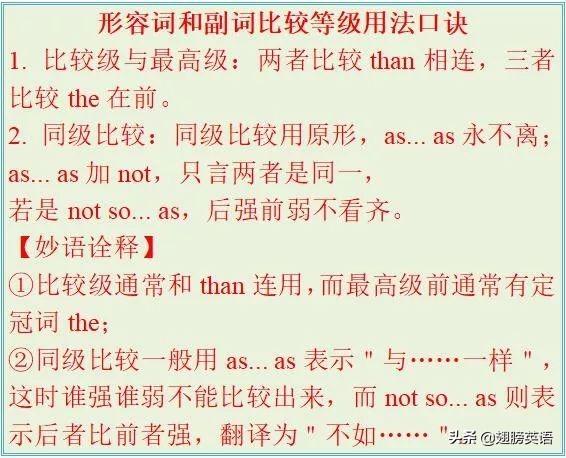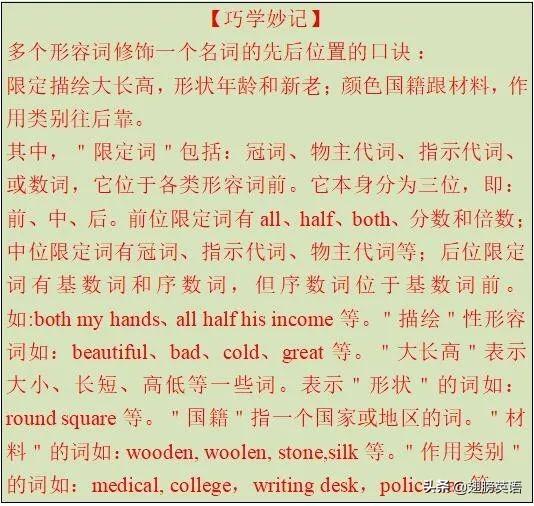考向一 形容词、副词的基本用法
1.形容词作状语表示伴随或结果,并不表达动作的方式。
After the long journey,the three of them went back home,hungry and tired.
经过长时间旅行后,他们三个回到家,又饿又累。
2.有些副词还可以作连词,作副词时常放在句末。如:though,(ever)since,in case等
He is old. He works hard,though.
=Though he is old,he works hard.
虽然他年事已高,但他工作还是很努力。
3.有些副词置于句首可修饰全句,作评注性状语。如:obviously,naturally,surprisingly等
Fortunately,he was not drowned and was saved by the PLA.
幸运的是,他没被淹死,被解放军给救了。
Happily for her,her stepmother was kind to her.
高兴的是,她的继母对她很好。
4.can not/never 与enough 或too连用表示:无论怎样都不过分;越……越好。
—I was riding alone in the street and all of a sudden,a car cut in and knocked me down.
——我正在大街上独自一人骑自行车,突然一辆小汽车强行超车把我撞倒了。
—You can never be too careful in the street.
— —在大街上你越小心越好。
考向二 形容词、副词的比较级和最高级
1."as+形容词+(a/an)+名词+as"表示同级比较,注意中间的形容词和名词并列时各自所在的位置。
It is generally believed that teaching is as much an art as it is a science.
人们普遍认为,教学是一门科学,同时也是一门艺术。
2."as+形容词/副词的原级+as"与"not as/so+形容词/副词的原级+as"表示同级比较,即两个或两部分人或物在性质上或程度上相同(不同)。
The work is not as/so difficult as you imagine.
这项工作不是像你想像的那么难。
3."the+比较级+of the two +名词"表示"两者中较……的那个"。
The taller of the two boys is my brother.
两个男孩中较高的那位是我哥哥。
4.a+形容词比较级+n.……
After two years'research,we have a far better understanding of the disease.
研究两年之后,现在我们对这种病有更好的理解。
We went to the USA in search of a better life.
为了寻找更美好的生活我们去了美国。
5.比较级的修饰语常见的有:rather,much,still,even,far,any(用于否定句或疑问句),a lot,a little,a great deal,by far,a bit 等。
The students study even harder than before.
学生们学习比以前更努力了。
A car runs a great deal faster than a bike.
汽车比自行车跑得快得多。
6.最高级
(1)最高级的修饰语常见的有:序数词,by far,nearly,almost,by no means,not really,not quite,nothing like。
The bridge being built now is by far the longest across the Yellow River.
目前正在建的那座桥是横跨黄河之上的桥当中最长的桥。
I'd like to buy the second most expensive camera.
我想买仅次于最贵的照相机。
(2)否定词+比较级=最高级。
There is no greater love than that of a man who lays down his life for his friends.
为朋友而放弃生命的人的爱是最伟大的爱。
—Are you satisfied with what he said at the meeting?
——你对他在会议上说的满意吗?
—No.It couldn't have been worse.
——不,不能再差了。
【巧学妙记】

【难点释疑】
比较级表示最高级含义
1. 比较级+than any other+可数名词单数
The Changjiang River is longer than any other river in China. 在中国,长江比其他任何一条河流都长。
2. 比较级+than all(the) other+可数名词复数
China is larger than all the other Asian countries. 中国比亚洲的其他国家都大。
3. no/never/nothing...+比较级
Nothing is more valuable than time. 时间比任何东西都珍贵。
4. "否定词+不定冠词+形容词的比较级+名词"或"否定词+副词的比较级"表示"从未……;未曾……"
This film is very moving. I have never seen a better one. 这部电影很感人,我从没有看过一部比它更好的。
考向三倍数表达法
表示倍数的句型:
(1)A is+倍数+比较级+than+B
(2)A is+倍数+as+原级+as+B
(3)A is+倍数+the+名词(size,length,height 等)+of+B
(4)A is+倍数+that+of+B
(5)A is+倍数+what 引导的名词性从句
①This building is three times higher than that one.
This building is three times as high as that one.
This building is three times the height of that one.
这个建筑物是那个建筑物的3倍高。
②The output of this year is 3 times that of 2008.
=The output of this year is 3 times what it was in 2008.
今年的产量是2008年的三倍。
③After the new technique was introduced,the factory produced twice as many cars in 2008 as the year before.
自从新技术被引进以后,这家工厂2008年生产的小汽车是上一年的两倍。
考点四多个形容词修饰名词的顺序
多个形容词修饰名词时,其顺序为:
限定词→数词→描绘词→(大小,长短,形状,新旧,颜色) →出处→材料性质→类别→名词
a small round table
a tall gray building
a dirty old brown shirt
a famous German medical school
an expensive Japanese sports car

考点五 形容词、副词辨析
形容词副词的区别及用法
1. late 和later
He is late. He is half an hour late.
他迟到了,迟到了半小时。
Three minutes later, he arrived.
三分钟后,他来了。
2. pleased, pleasing与pleasant
(1)pleased的含义是"感到满意,高兴",后常跟介词at, with。例如:
I'm pleased to see you here.
在这儿见到你很高兴。
She's pleased with our programme.
她对我们的节目很满意。
(2)pleasing表示"令人欣喜的",相当于"giving pleasure"。例如:
My sister's progress in dancing is pleasing.
我姐姐在舞蹈方面的进步令人高兴。
The baby has a pleasing voice.
这个婴儿的声音很悦耳。
(3)pleasant表示"快乐的,愉快的"。例如:
The girl has a pleasant childhood.
这个女孩有一个快乐的童年。
To have a pleasant holiday is my favorite.
过一个愉快的假期是我最喜欢的。
3. living, alive与live
(1)living作定语时,既可置于所修饰的名词之前,也可置于所修饰的名词之后,译为"活着的,当代的"。在句中充当定语及表语。例如:
Not all living things live on sunlight.
并非所有的生物都依赖阳光生存。
My grandparents are still living.
我的祖父母仍然健在。
(2)alive译为"活着的",可以在句中作表语及定语。作定语时,位于它所修饰的名词之后。例如:
He may be the busiest person alive.
他可能是世上最忙的人了。
Is that sheep dead or alive?
那头羊是死了还是活着?
(3)alive还有"活泼的,活动的,有生机的"之意。例如:
You seem very much alive today.
你今天看起来很活跃。
(4)live表示"活着的",做"现场直播"讲时可以用作形容词、副词,在句子中可以作定语,表语。
The programme is live./The programme is broadcast live.
这个节目是现场直播的。
4. worth,worthy与worthwhile
(1)worth意为"值得的",后接v-ing形式,构成"be worth doing"结构,也可接表示价格的名词及钱数;
(2)worthy意为"值得的",后接"of+名词(或being+过去分词)",构成"be worthy of+名词(或being done)"结构或"be worthy to be done"结构。
(3)be worthwhile to do sth/doing sth例如:
This coat is worth one hundred yuan.
这件上衣价值一百元。
This problem is worthy of being discussed.
这个问题值得讨论。
5. too、also、either
too和also用于肯定句、疑问句,too多用于口语,also多用于书面语,either用于否定句。Too常用在句末,also常用在句中。
Are they coming too ?
他们也来吗?
She is young and beautiful, and also rich.
她年轻漂亮,而且有钱。
He hasn't finished it, either.
他也还没有做完。
6. likely与possible, probable
likely 的主语可以是it也可以是名词或其它代词,而possible和probable只能用it作主语。
7. most 与mostly
most做形容词或代词,如:most students, most of us;mostly为副词,表示大部分情况下,或成分中大部分。
The sauce is mostly cream.
这沙司主要是奶油。
We're mostly out on Sundays.
我们星期天一般不在家。
考点六几组难点句型详解
句型1:A is 倍数+the size/length/weight/height…of B.如:
The newly broadened square is four times the size of the previous one.
新扩建的广场是前一个的四倍大。
句型2:A is to B what C is to D. 意为"A对于B就如C对于D。"如:
Engines are to machines what hearts are to animals. 发动机对于机器就如心脏对于动物。
句型3:can't be too+adj. = can't be+adj.+enough无论……都不为过,越……越…… 如:
You can never be careful enough.= You can never be too careful.你无论怎么小心都不为过。
句型4:too…to句型的两个意义
(1) 表示否定意义,意为"太……而不能"。如:
This question is too hard for me to understand.
这个问题对我来说太难理解了。
(2) 表示肯定意义,意为"非常,很,极"。当too后面接easy,ready, eager, inclined, willing, thankful, delighted等形容词时,too表示"很,非常"之意,与very表达"很"的意思相同。当too前有all, but, only等词时,形成only /but/all too…to do结构,仍旧表达"非常,很,极"之意。如:
I'm too glad to hear that.
我对此感到非常高兴。
 加载中,请稍侯......
加载中,请稍侯......
精彩评论